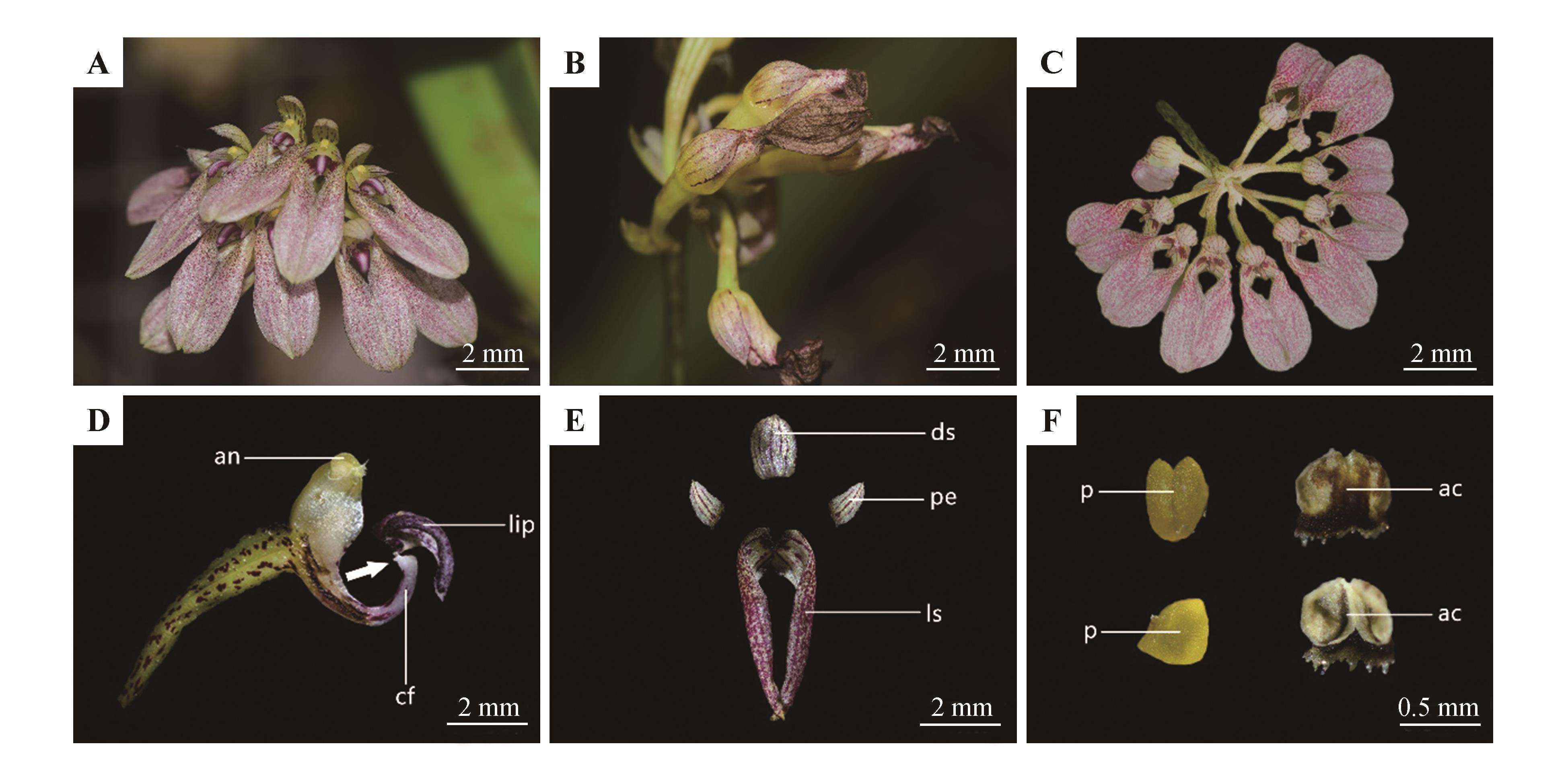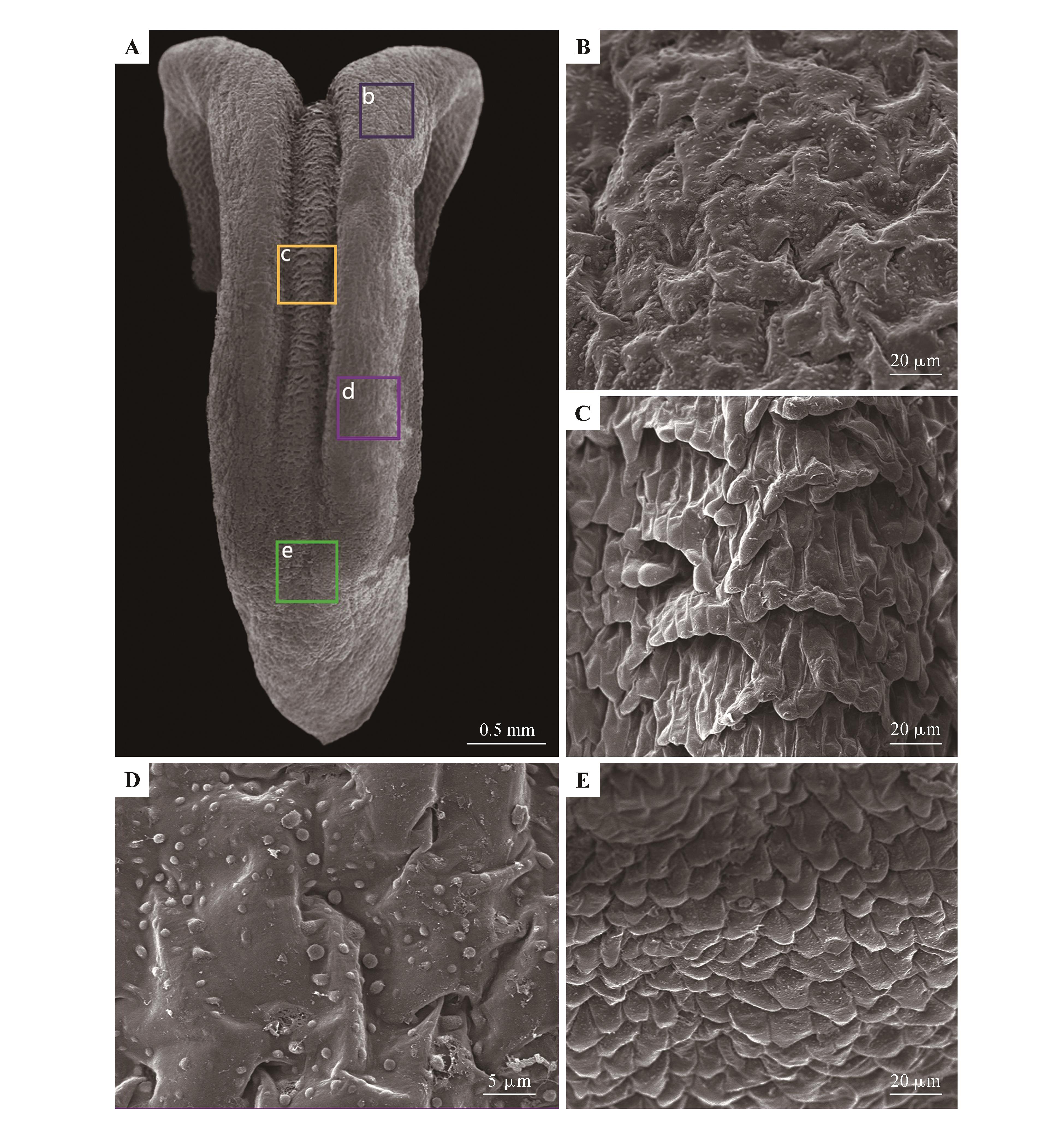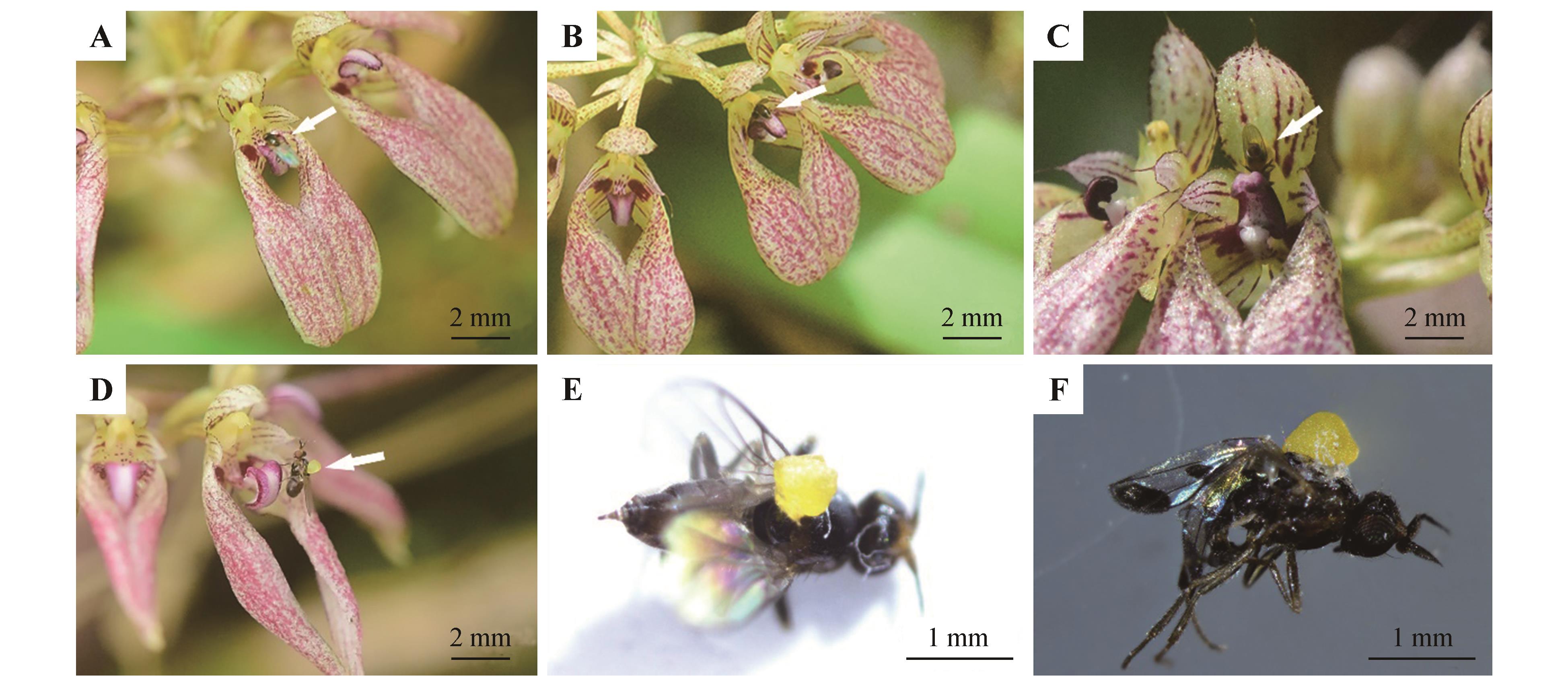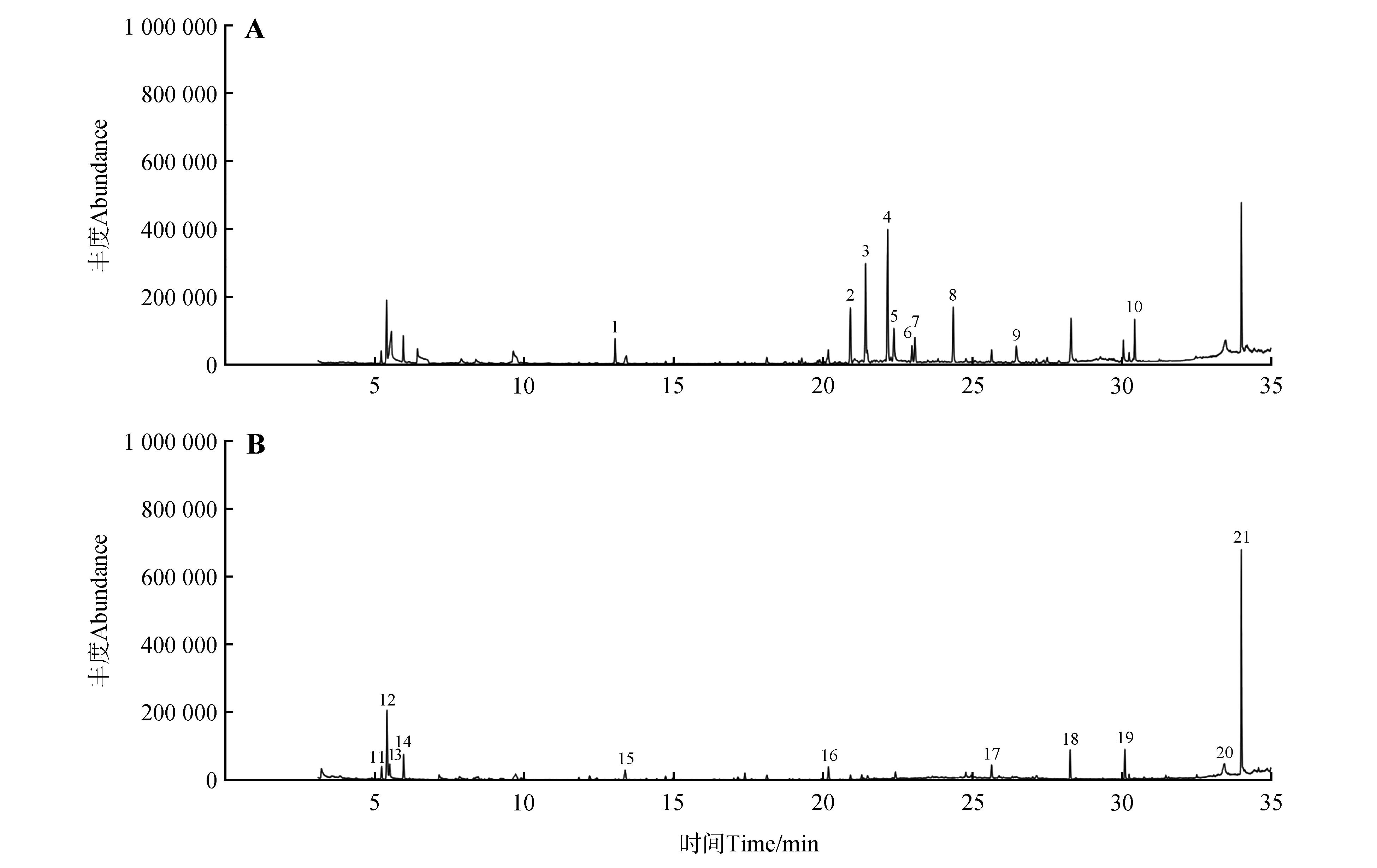Bulletin of Botanical Research ›› 2024, Vol. 44 ›› Issue (5): 681-691.doi: 10.7525/j.issn.1673-5102.2024.05.005
• Plant reproductive biology • Previous Articles Next Articles
Jinrui HE1,2, Xiong ZHANG3, Yinling LUO4, Yan LUO2, Qingqing LI1,5( )
)
Received:2024-01-29
Online:2024-09-20
Published:2024-09-23
Contact:
Qingqing LI
E-mail:doublelqq@163.com
CLC Number:
Jinrui HE, Xiong ZHANG, Yinling LUO, Yan LUO, Qingqing LI. Adaptability of Floral Characteristics to a Fly Pollinator in Bulbophyllum andersonii (Orchidaceae)[J]. Bulletin of Botanical Research, 2024, 44(5): 681-691.
Add to citation manager EndNote|Ris|BibTeX
URL: https://bbr.nefu.edu.cn/EN/10.7525/j.issn.1673-5102.2024.05.005

Fig.1
Flower morphological characters of B. andersoniiA.Unpollinated inflorescence, showing flower expanding;B.Pollinated inflorescence, showing wilted flower and enlarged ovary;C.Expanded inflorescence,showing flower number;D.Column and labellum,white arrow showing the hinge structure;E.Sepals and petals;F.Pollinium and anther cap;an.Anther;lip.Labellum;cf.Column foot;ds.Dorsal sepal;pe.Petal;ls.Lateral sepal;p.Pollinium;ac.anther cap.


Fig.2
Epidermal cell micromorphology of the lip of B. andersonii(under SEM)A.Labellum, boxes showing the ridge on both sides(blue),the groove(yellow),ridges on both sides(purple) and the apex(green),respectively;B.Enlarged blue box b showing epidermal cells of ridge of labellum base;C.Enlarged yellow box c showing epidermal cells of the groove;D.Enlarged purple box d showing epidermal cells of ridge of central;E.Enlarged green box e showing epidermal cells of the apex.


Fig.3
Pollination process of B. andersonii by Gampsocera sp.(white arrow)A.Gampsocera sp. was on the lip of B. andersonii;B-C.Gampsocera sp. was stuck in pollination channels;D.Gampsocera sp. carrying pollinium; E.Female Gampsocera sp. carrying with pollinium;F.Male Gampsocera sp. carrying with pollinium.

Table 2
Comparison of functional traits of B. andersonii and its pollinators
物种 Species | 个体数量 n | 入口高/胸高 Height of the entrance or mesothorax/mm | 入口宽/体宽 Width of the entrance or body/mm | 入口深/体长 Length of the entrance or body/mm |
|---|---|---|---|---|
| 梳帽卷瓣兰B. andersonii | 15 | 0.85±0.02a | 0.81±0.02a | 2.47±0.09a |
| 曲角秆蝇(雌性)Gampsocera sp. | 10 | 0.79±0.01b | 0.72±0.07b | 2.23±0.02b |
| 曲角秆蝇(雄性)Gampsocera sp. | 10 | 0.78±0.06b | 0.70±0.05b | 2.01±0.03c |
Table 3
Identification of volatile compounds in B. andersonii
化合物 Compound | 保留时间 Retention time/min | 相对含量 Relative content/% |
|---|---|---|
| 邻苯乙醚1,2-Dimethoxybenzene | 13.04 | 3.95±0.02 |
| (E)-α-佛手柑烯(E)-alpha-bergamotene | 20.91 | 11.80±0.01 |
| β-柏木烯Beta-Cedrene | 21.42 | 17.83±0.03 |
| 马兜铃烯Aristolochene | 22.15 | 26.75±0.01 |
| 巴伦西亚橘烯Valencene | 22.37 | 6.75±0.01 |
| 八氢萘Octahydronaphthalene | 22.97 | 3.56±0.01 |
| α-蒎烯Alpha-Copaene | 23.07 | 5.93±0.01 |
| 避蚊胺N,N-diethyl-m-toluamide | 24.36 | 11.69±0.07 |
| 4,6-二氯嘧啶-5-甲腈4,6-Dichloropyrimidine-5-carbonitrile | 26.46 | 7.38±0.04 |
| 邻苯二甲酸非5-炔-3-基异丁酯Phthalic acid,isobutyl non-5-yn-3-yl ester | 30.43 | 4.36±0.02 |

Fig.5
The ion chromatogram of volatile componentsA.Volatile components in flower of B. andersonii;B.Air(control);1. 1,2-Dimethoxybenzene;2.(E)-alpha-bergamotene;3.Beta-Cedrene;4.Aristolochene;5.Valencene;6.Octahydronaphthalene;7.Alpha-Copaene;8.N,N-diethyl-m-toluamide;9. 4,6-Dichloropyrimidine-5-carbonitrile;10.Phthalic acid,isobutyl non-5-yn-3-yl ester;11.Ethylbenzene;12.M-xylene;13.Isopropyl alcohol;14.P-Xylene;15. 1,4-Benzenedicarboxylic acid,1,4-bis(4-amino-2-methylphenyl) ester;16. 2-Methyl-5-hexenenitrile;17.Ethylene glycol-Adipate-Diethylene glycol;18.Tetradecanoic acid;19. 1,2-Benzenedicarboxylic acid,bis(2-methylpropyl) ester;20. 2,4-Bis(1-phenylethyl)phenol;21.Bisphenol a.

| 1 | WHITTALL J B, HODGES S A.Pollinator shifts drive increasingly long nectar spurs in columbine flowers[J].Nature,2007,447(7145):706-709. |
| 2 | 黄双全,郭友好.传粉生物学的研究进展[J].科学通报,2000,45(3):225-237. |
| HUANG S Q, GUO Y H.Progress in pollination biology[J].Chinese Science Bulletin,2000,45(3):225-237. | |
| 3 | NUTTMAN C V, SEMIDA F M, ZALAT S,et al.Visual cues and foraging choices:bee visits to floral colour phases in Alkanna orientalis(Boraginaceae)[J].Biological Journal of the Linnean Society,2006,87(3):427-435. |
| 4 | ASHMAN T L, BRADBURN M, COLE D H,et al.The scent of a male:the role of floral volatiles in pollination of a gender dimorphic plant[J].Ecology,2005,86(8):2099-2105. |
| 5 | ZHAO Y H, REN Z X, LÁZARO A,et al.Floral traits influence pollen vectors' choices in higher elevation communities in the Himalaya-Hengduan Mountains[J].BMC Ecology,2016,16:26. |
| 6 | GRAVENDEEL B, FISCHER G A, VERMEULEN J J. Bulbophyllum Thouars[M]// PRIDGEON A M,CRIBB P J,CHASE M W,et al.Genera Orchidacearum:Vol: 6.Oxford:Oxford University Press,2014:46-49. |
| 7 | ONG P T, TAN K H.Fly pollination in four Malaysian species of Bulbophyllum(Section Sestochilus) - B.lasianthum,B.lobbii,B.subumbellatum and B.virescens [J].Malesian Orchid Journal,2011,8:103-110. |
| 8 | TAN K H, ONG P T, TAN L T,et al.Morphology and movement of Bulbophyllum hortorum(Orchidaceae) flowers enable selection of optimal-sized Dacini fruit fly males as pollinators[J].Arthropod-Plant Interactions,2023,17:647-660. |
| 9 | BORBA E L, SEMIR J.Wind-assisted fly pollination in three Bulbophyllum(Orchidaceae) species occurring in the Brazilian campos rupestres[J].Lindleyana,1998,13(3):203-218. |
| 10 | DE PÁDUA TEIXEIRA S, BORBA E L, SEMIR J.Lip anatomy and its implications for the pollination mechanisms of Bulbophyllum species(Orchidaceae)[J].Annals of Botany,2004,93(5):499-505. |
| 11 | DAVIES K L, STPICZYŃSKA M.Labellar anatomy and secretion in Bulbophyllum Thouars(Orchidaceae:Bulbophyllinae) sect.Racemosae Benth.& Hook.F[J].Annals of Botany,2014,114(5):889-911. |
| 12 | KOWALKOWSKA A K, TURZYŃSKI S, KOZIERADZKA-KISZKURNO M,et al.Floral structure of two species of Bulbophyllum section Cirrhopetalum Lindl.:B.weberi Ames and B.cumingii(Lindl.) Rchb.f.(Bulbophyllinae Schltr.,Orchidaceae)[J].Protoplasma,2017,254:1431-1449. |
| 13 | CHEN S C, VERMEULEN J J. Bulbophyllum Thouars[M]//WU Z Y,RAVEN P H,HONG D Y.Flora of China:Vol.25.Beijing:Science Press,2009:404-440. |
| 14 | 陈玲玲,高江云.芳香石豆兰的繁殖生态学[J].植物生态学报,2011,35(11):1202-1208. |
| CHEN L L, GAO J Y.Reproductive ecology of Bulbophyllum ambrosia(Orchidaceae)[J].Chinese Journal of Plant Ecology,2011,35(11):1202-1208. | |
| 15 | CHEN L J, ZHANNG G Q, LI L Q,et al.Development and maintenance of a cross-mixed mating system in the orchid Bulbophyllum orientale [J].Journal of Phylogenetics & Evolutionary Biology,2014,2(1):124. |
| 16 | LIU Z J, CHEN L J, LIU K W,et al.A floral organ moving like a caterpillar for pollinating[J].Journal of Systematics and Evolution,2010,48(2):102-108. |
| 17 | 施嘉雯,钱永辉,罗艳,等.植物园迁地保护环境下纹瓣兰的繁殖生物学研究[J].热带亚热带植物学报,2024,32(3):397-408. |
| SHI J W, QIAN Y H, LUO Y,et al.Reproductive biology of Cymbidium aloifolium(Orchidaceae) under ex situ conservation in botanical garden[J].Journal of Tropical and Subtropical Botany,2024,32(3):397-408. | |
| 18 | NARTSHUK E P.Grass-fly larvae(Diptera,Chloropidae):diversity,habitats,and feeding specializations[J].Entomological Review,2014,94(4):514-525. |
| 19 | BORBA E L, SEMIR J.Pollinator specificity and convergence in fly-pollinated Pleurothallis(Orchidaceae) species:a multiple population approach[J].Annals of Botany,2001,88(1):75-88. |
| 20 | NUNES E L P, SMIDT E C, STÜTZEL T,et al.Comparative floral micromorphology and anatomy of species of Bulbophyllum section Napelli(Orchidaceae),a Neotropical section widely distributed in forest habitats[J].Botanical Journal of the Linnean Society,2015,177(3):378-394. |
| 21 | WHITNEY H M, KOLLE M, ANDREW P,et al.Floral iridescence,produced by diffractive optics,acts as a cue for animal pollinators[J].Science,2009,323(5910):130-133. |
| 22 | STPICZYŃSKA M, PŁACHNO B J, DAVIES K L,et al.Nectar and oleiferous trichomes as floral attractants in Bulbophyllum saltatorium Lindl.(Orchidaceae)[J].Protoplasma,2018,255:565-574. |
| 23 | VAN DER CINGEL N A.An atlas of orchid pollination:European orchids[M].Brookfield:CRC Press,2001. |
| 24 | WIŚNIEWSKA N, LIPIŃSKA M M, GOŁĘBIOWSKI M,et al.Labellum structure of Bulbophyllum echinolabium J.J.Sm.(section Lepidorhiza Schltr.,Bulbophyllinae Schltr.,Orchidaceae Juss.)[J].Protoplasma,2019,256:1185-1203. |
| 25 | KOWALKOWSKA A K, KOZIERADZKA-KISZKURNO M, TURZYŃSKI S.Morphological,histological and ultrastructural features of osmophores and nectary of Bulbophyllum wendlandianum(Kraenzl.) Dammer(B.section Cirrhopetalum Lindl.,Bulbophyllinae Schltr.,Orchidaceae)[J].Plant Systematics and Evolution,2015,301:609-622. |
| 26 | FEINSTEIN J, PURZYCKI K L, MORI S,et al.Neotropical soldier flies(Stratiomyidae) reared from Lecythis poiteaui in French Guiana:do bat-pollinated flowers attract saprophiles?[J].The Journal of the Torrey Botanical Society,2009,135(2):200-207. |
| 27 | TAN K H, NISHIDA R, TOONG Y C.Floral synomone of a wild orchid,Bulbophyllum cheiri,lures Bactrocera fruit flies for pollination[J].Journal of Chemical Ecology,2002,28:1161-1172. |
| 28 | TAN K H, TAN L T, NISHIDA R,et al.Floral phenylpropanoid cocktail and architecture of Bulbophyllum vinaceum orchid in attracting fruit flies for pollination[J].Journal of Chemical Ecology,2006,32:2429-2441. |
| 29 | TAN K H, NISHIDA R.Zingerone in the floral synomone of Bulbophyllum baileyi(Orchidaceae) attracts Bactrocera fruit flies during pollination[J].Biochemical Systematics and Ecology,2007,35(6):334-341. |
| 30 | TAN K H, NISHIDA R.Synomone or Kairomone?—Bulbophyllum apertum flower releases raspberry ketone to attract Bactrocera fruit flies[J].Journal of Chemical Ecology,2005,31(3):497-507. |
| 31 | HUMEAU L, MICHENEAU C, JACQUEMYN H,et al.Sapromyiophily in the native orchid,Bulbophyllum variegatum,on Réunion(Mascarene archipelago,Indian Ocean)[J].Journal of Tropical Ecology,2011,27(6):591-599. |
| 32 | DEMILO A B, CUNNINGHAM R T, MCGOVERN T P.Structural variants of Methyl Eugenol and their attractiveness to the oriental fruit fly(Diptera:Tephritidae)[J].Journal of Economic Entomology,1994,87(4):957-964. |
| 33 | LAMPMAN R L, METCALF R L, ANDERSEN J F.Semiochemical attractants of Diabrotica undecimpunctata howardi barber,southern corn rootworm,and Diabrotica virgifera virgifera leconte,the western corn rootworm(Coleoptera:Chrysomelidae)[J].Journal of Chemical Ecology,1987,13(4):959-975. |
| 34 | JÜRGENS A, WITT T, GOTTSBERGER G.Flower scent composition in night-flowering Silene species(Caryophyllaceae)[J].Biochemical Systematics and Ecology,2002,30(5):383-397. |
| 35 | KAIN P, BOYLE S M, THARADRA S K,et al.Odour receptors and neurons for DEET and new insect repellents[J].Nature,2013,502:570-512. |
| [1] | Wenyan XIONG, Yawen WU, Tian BAI, Weijia XIE, Yan DONG, Jingli ZHANG. Breeding System and Hybridization Affinity of Rhododendron irroratum [J]. Bulletin of Botanical Research, 2024, 44(3): 370-379. |
| [2] | Yanqing CAI, Yujun CHEN, Mei LI, Chuangfa DENG, Liejian HUANG. Flowering Biological Characteristics and Breeding System of Lumnitzera racemosa [J]. Bulletin of Botanical Research, 2024, 44(1): 152-160. |
| [3] | Qiongyue LIANG, Changqiu LIU, Qifeng LU, Tao DENG, Bo CAI. The Pollination Biology of Begonia Guangxiensis, a Narrowly Distributed Species [J]. Bulletin of Botanical Research, 2023, 43(3): 432-438. |
| [4] | Changrui TAI, Kai ZHAO, Yanfang YANG, Yan WU, Wei ZHAI, Yuewei TONG. Flowering Biological Characteristics and Breeding System of the Rare and Endangered Plant of Sinojackia microcarpa [J]. Bulletin of Botanical Research, 2023, 43(2): 311-320. |
| [5] | Wenjing WANG, Hongfan CHEN, Guojun SHAO, Hong LIAO, Jianli ZHAO, Qingjun LI. Nectary Structure of Selfing and Outcrossing Speciesin Roscoea [J]. Bulletin of Botanical Research, 2022, 42(3): 364-372. |
| [6] | ZHAO Xiao-Yi, WANG Zhong-Ke, LI Gui-Fang, LÜ Xin-Hua, ZHAO Wen-Qin, ZHUANG Li. A Study on Breeding Characteristics and Ecological Adaptability of the Ferula ferulaeoides [J]. Bulletin of Botanical Research, 2019, 39(3): 321-328. |
| [7] | LI Ya-Lan, LIANG Feng-Li. Stamen Dynamics and Breeding System of Lonicera alberti [J]. Bulletin of Botanical Research, 2016, 36(4): 503-510. |
| [8] | XU Xiao-Yuan;ZHOU Ling-Ling*;WANG Zhong-Ke;ZHUANG Li. Flower Distyly and Breeding System of Limonium chrysocomum [J]. Bulletin of Botanical Research, 2015, 35(6): 883-890. |
| [9] | LIU Kai-Quan;DENG Hong-Ping*. Floral Biology and Breeding System of Endangered Plant Scutellaria tsinyunensis Endemic to Chongqing,China [J]. Bulletin of Botanical Research, 2011, 31(4): 403-407. |
| [10] | WANG Ya-Li;WANG Jin-Xiu;CHANG Hong-Yu;NI Xi-Lu;TIAN Ying;QIN Bin-Bin. Flowering Biology of Lycium barbarum L. NQ-2 [J]. Bulletin of Botanical Research, 2011, 31(3): 330-335. |
| [11] | LI Jin-Xia;SU Xue;LIU Yu-Guo;CHEN Ming-Zhong;SUN Kun*. Flowering Dynamics and Breeding System of Incarvillea sinensis var. przewalskii [J]. Bulletin of Botanical Research, 2011, 31(2): 147-151. |
| [12] | SONG Yu-Xia;GUO Sheng-Hu;NIU Dong-Ling;ZHENG Guo-Qi;MA Hong-Ai;LI Miao. A Study on Breeding System of the Endangered Plant Cistanche deserticola [J]. Bulletin of Botanical Research, 2008, 28(3): 278-282. |
| [13] | WEI Xue-Zhi;LIU Ya-Juan;GUO Xiao-Hu;LIANG Jian-Dong;SHI Li-Xin;GONG Jiang-Qiao. The Primary Study on Pollination Biology of a Protective Plant,Elaeagnus Mollis Diels [J]. Bulletin of Botanical Research, 2007, 27(6): 753-757. |
| [14] | Liu Xiang-jun, Ding Mei-mei, Zhang Gui-xiang, Zhao Li, Li Rui-jun. STUDIES ON FLOWER BIOLOGY AND BREEDING SYSTEM OF VICIA L.IN NORTHEAST CHINA [J]. Bulletin of Botanical Research, 1997, 17(4): 421-430. |
| Viewed | ||||||
|
Full text |
|
|||||
|
Abstract |
|
|||||